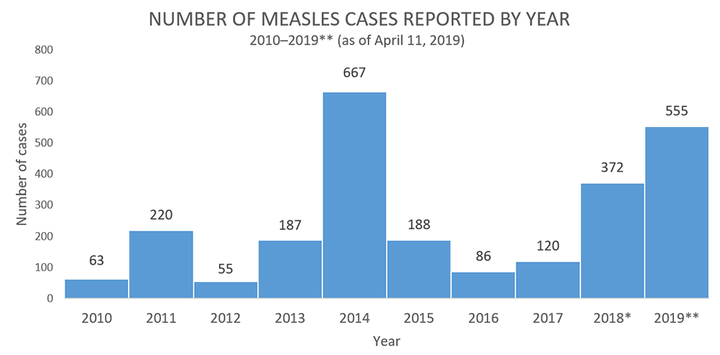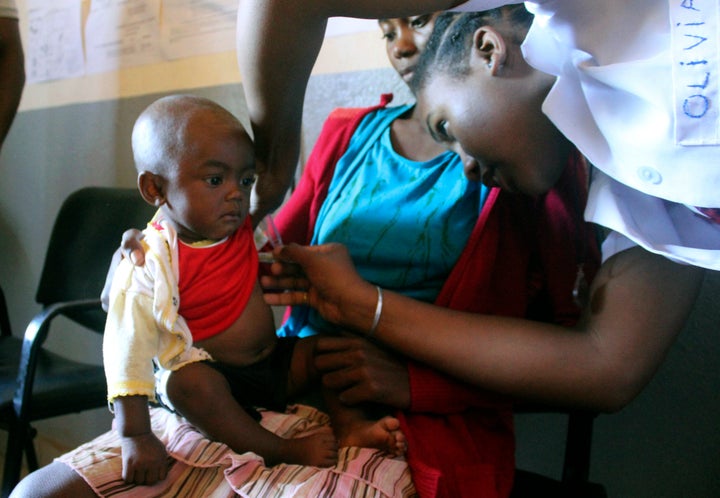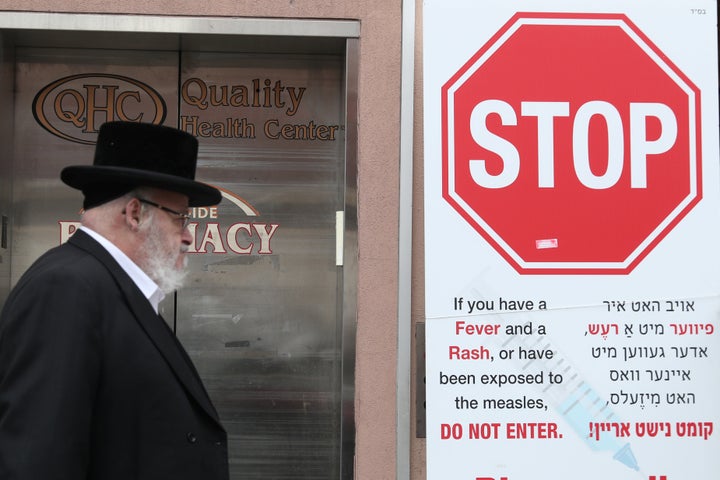Measles cases in the U.S. are at the second-highest level in 25 years, with the number expected to rise.
There have been 555 reported measles cases in 2019 as of last Thursday, according to figures the Centers for Disease Control and Prevention released Monday.
That’s 183 cases more than last year, and only 112 cases fewer than in 2014, when there were 667 cases. Since it’s only April, this year’s number is likely to surpass 2014′s and could rival the 963 cases in 1994, 25 years ago.
As of last week, the CDC said the disease has spread to five more states ― Florida, Indiana, Maryland, Massachusetts and Nevada ― bringing the total number of states affected up to 20.

Arizona, California, Colorado, Connecticut, Florida, Georgia, Illinois, Indiana, Kentucky, Maryland, Massachusetts, Michigan, Missouri, Nevada, New Hampshire, New Jersey, New York, Oregon, Texas and Washington have reported measles cases.
“I’m obviously very concerned about the size and also acceleration of the current outbreak,” Dr. Nancy Messonier, director of the CDC’s National Center for Immunization and Respiratory Diseases, told CNN. “This is not going to stop on its own.”
Measles is on the rise globally, with 300% more reported cases in the first three months of 2019 than in the same period last year, the World Health Organization said on Monday.
There are currently outbreaks in the Democratic Republic of Congo, Ethiopia, Georgia, Kazakhstan, Kyrgyzstan, Madagascar, Myanmar, the Philippines, Sudan, Thailand and Ukraine.
The outbreak in Madagascar, the largest in the country’s history, has killed more than 1,200 people, most of them children, The Associated Press recently reported. Officials attribute the high number of deaths to low vaccination rates, poverty and malnutrition.
“In 2017, the most recent year for which estimates are available, it caused close to 110,000 deaths,” the WHO said in a release. “Even in high-income countries, complications result in hospitalization in up to a quarter of cases, and can lead to lifelong disability, from brain damage and blindness to hearing loss.”

Measles was nearly eliminated in the U.S. in 2000. The CDC attributes the rise of measles cases in the country to outbreaks in unvaccinated communities after travelers overseas contracted the disease and brought it to the U.S.
Last year, 82 people brought measles to the U.S. from other countries. It was the greatest number of imported cases since 2000.
Health officials have urged the public to get vaccinated for the disease, as the majority of people who have contracted measles were unvaccinated.
New York City Mayor Bill de Blasio declared a public health emergency last week that would require vaccinations for people living in Williamsburg, Brooklyn, where parents in ultra-Orthodox communities oppose vaccinating their children.

Three major outbreaks last year in New York State, New York City and New Jersey contributed to most of the year’s measles cases. Those cases occurred primarily among unvaccinated people in Orthodox Jewish communities, the CDC said.
The measles virus, which invades the nose and throat, spreads through coughing and sneezing. It causes fever and congestion and can lead to disabling or fatal complications, including severe diarrhea, pneumonia and brain inflammation.
The virus can live up to two hours in the air where an infected person coughed or sneezed. The vaccine is 97% effective, authorities say.
“Measles is so contagious that if one person has it, up to 90% of the people close to that person who are not immune will also become infected,” the CDC has said.
Credit: Source link